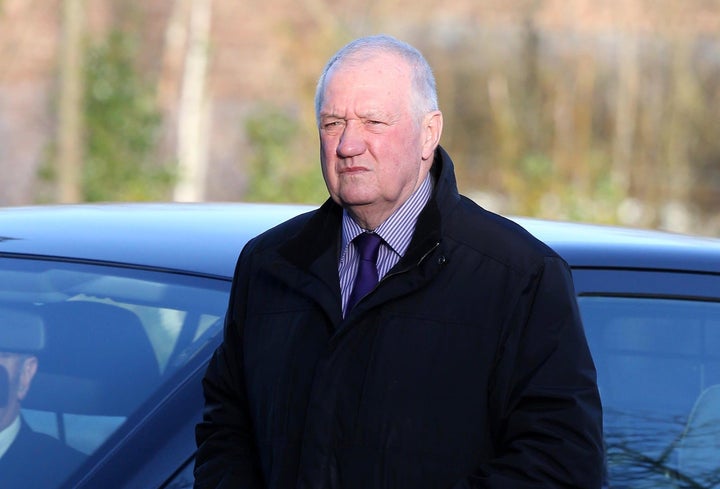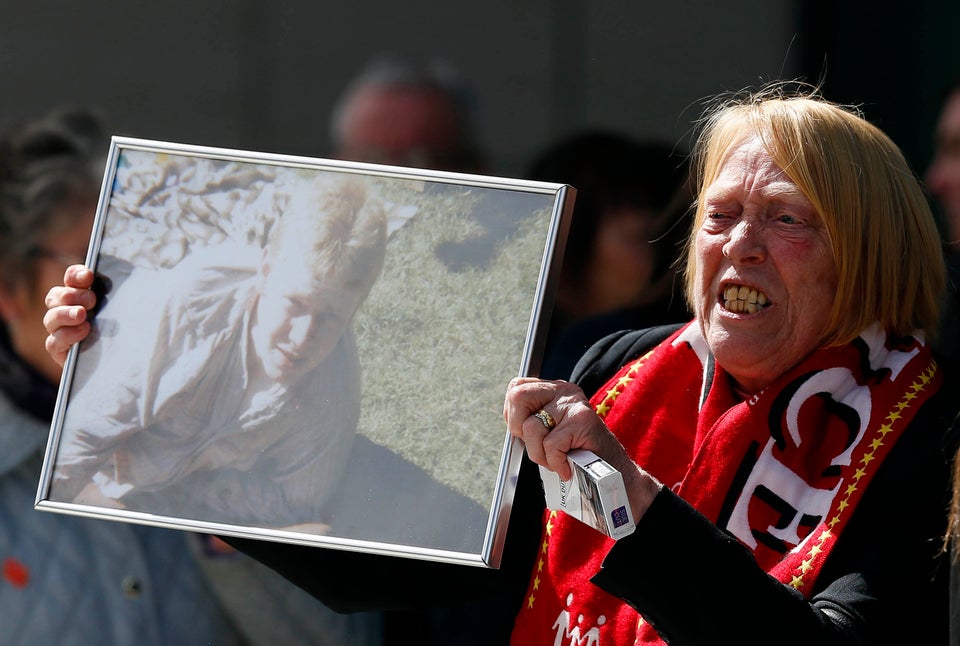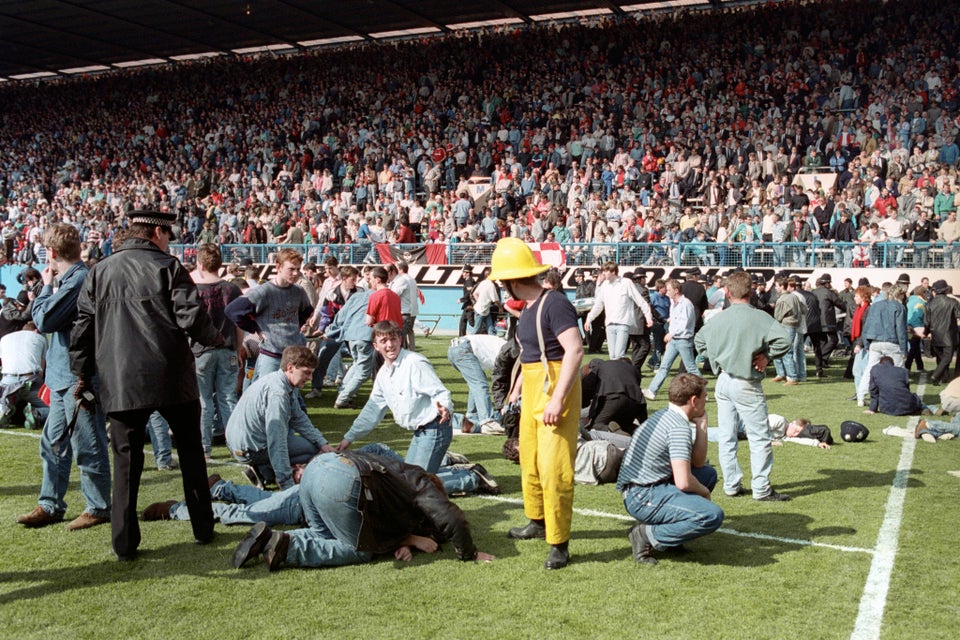- 96 Liverpool fans who died at Hillsborough WERE unlawfully killed
- Jury rules fan behaviour did NOT cause or contribute to the tragedy
- CPS confirms it will begin process of considering criminal charges
- Police planning errors 'caused or contributed' to the situation
- Tragedy happened 'as a result of crushing' in Leppings Lane terrace
The families and friends of victims of Liverpool supporters killed in the Hillsborough disaster have cheered jurors from court after they concluded the 96 football fans had been unlawfully killed.
Declaring that justice had finally been done, there were shouts of "God bless the jury" as the conclusions into Britain's worst sporting disaster were read out. They found it was unlawful killing by a 7-2 majority.
The verdicts were greeted with sobbing and cheers at the hearing in Warrington.
Within minutes of the findings being released, the Crown Prosecution Service confirmed it would begin the process of formally considering criminal charges over the disaster.
Dozens of relatives of the victims have attended each of the more than 300 days the court has sat.
As families left the building they were met with applause from crowds who had gathered outside the court in support.
The jury also ruled that fan behaviour did not cause or contribute to the tragedy.
Lawyers acting for the families said the conclusions, at the end of the longest jury case in British legal history, had completely vindicated their tireless 27-year battle.
Labour MP Andy Burnham, who has supported the campaign, said: "This has been the greatest miscarriage of justice of our times. "But, finally, it is over."
Lib Dem MP for Southport John Pugh called on David Cameron to make a "formal apology on the floor of the House to the Hillsborough families and Liverpool."
The Hillsborough disaster unfolded during Liverpool's FA Cup semi-final tie against Nottingham Forest on April 15 as thousands of fans were crushed at Sheffield Wednesday's ground.
The fresh inquest followed a dogged campaign for justice by the loved ones of those who died.
The inquest jury of six women and three men delivered their verdicts just after 11am, 27 years after the stadium crush, concluding the longest jury proceedings in English legal history and coming after a protracted battle for justice.
The jury, sitting in Warrington, Cheshire, found police planning errors 'caused or contributed' to the dangerous situation that developed on the day of the disaster.
Jurors gave their conclusions having answered a general questionnaire of 14 questions as well as a record of the time and cause of death for each of the Liverpool fans, 27 years and 12 days since the disaster on April 15, 1989.
These included questions about the police planning before the game, stadium safety, events on the day, the emergency services' response to the disaster and whether the fans were unlawfully killed.
The jury found that:
- Both the police and the ambulance service caused or contributed to the loss of lives in the disaster by an error or omission after the crush in the west terrace had begun to develop
- They found unanimously that policing of the match caused or contributed to a dangerous situation developing at the Leppings Lane turnstiles
- Commanding officers caused or contributed to the crush on the terrace as did those senior officers in the police control box when the order was given to open the exit gates at the Leppings Lane end
- Features of the design, construction and layout of the stadium considered to be dangerous or defective caused or contributed to the disaster
- The safety certification and oversight of the stadium also played a part
- Sheffield Wednesday's then consultant engineers, Eastwood & Partners, should have done more to detect and advise on any unsafe or unsatisfactory features of the stadium which caused or contributed to the disaster
The conclusions follow previous inquests in 1991, which recorded verdicts of accidental death.
That ruling was later quashed after it was claimed that authorities had manipulated the timing of events to deflect blame from them and on to fans.
No evidence of the emergency response after 3.15pm was heard at the original inquests.
The medical experts who gave evidence at the fresh inquests said the 3.15pm cut-off which had been imposed in the original inquests was arbitrary and wrong.
The cut-off was based on a misunderstanding, the court heard previously, that all of those who died were either dead or had suffered such severe brain injury by that time that it would inevitably prove to be fatal whatever the nature of the response.
South Yorkshire Police Chief Constable David Compton said the force would "unequivocally accept the verdict of unlawful killing" and admitted that officers had got policing of the cup tie "catastrophically wrong".
The apology from South Yorkshire Police was not enough for Burnham, who said the force's behavior had been "regrettable".
"Disgracefully, lawyers for the retired officers have thrown the same old slurs around in this court room that I’m sat outside.
"The cover up has carried on in this courtroom at great public expense. Those things have to be answered I think it is a terrible, terrible thing to have put the Hillsborough families through all that hurt again in this court room and I do believe the South Yorkshire Police needs to be held to account for that."
The 1991 accidental deaths verdicts from the original inquests were quashed following the 2012 Hillsborough Independent Panel, which concluded that a major cover-up had taken place in an effort by police and others to avoid the blame for what happened.
Football pundit Gary Lineker and Manchester United striker Wayne Rooney, who grew up in Liverpool, were among many offering support for the victims and families after the fresh verdicts today.
The Sun's response to the disaster earned it massive enmity from Liverpudlians. It ran a headline proclaiming 'The Truth', accusing Liverpool fans of causing the disaster and then obstructing police who were trying to help.
After the Hillsborough Independent Panel (HIP) shed light on what really happened in September 2012, the paper apologised.
Then-editor Kelvin Mackenzie offered his 'profuse apologies' for the headline, which did little to quell ill-feeling towards the paper in the city.
Boris Johnson also apologised for a 2004 article in The Spectator about the disaster, which accused Liverpool of having a "victim culture" in the wake tragedy's wake.
"I was very, very sorry in 2004 that the Spectator did carry an editorial that partially repeated those allegations, I apologised then and I apologise now," he said after the HIP reported.
Before they were sent out on April 6 to start their deliberations, jurors were told they could only answer "yes" to question six if they were sure that match commander Chief Superintendent David Duckenfield owed a duty of care to those who died in the disaster, and that he was in breach of that duty of care.
Scroll down for more...
Thirdly, they would need to be satisfied that his breach of duty caused the deaths and, fourthly, that it amounted to "gross negligence".
Mr Duckenfield gave the order at 2.52pm to open exit Gate C in Leppings Lane, allowing around 2,000 fans to flood into the already packed central pens behind the goal.
Criminal investigations into the disaster and claims of corruption in its aftermath could finish by the end of the year, when prosecutors will decide whether to charge any individual or organisation.
The officer leading the police inquiry, Assistant Commissioner Jon Stoddart, said: "Now that the inquests have concluded, my sole focus is on completing the criminal investigation which I expect will be finished by the turn of the year.
"It will then be for the Crown Prosecution Service to consider the evidence and decide whether any individual or organisation should face criminal prosecution."
The Independent Police Complaints Commission, the official police watchdog, also expects its investigation - the biggest in its history - to finish in December or January.

The hearings have been ongoing for more than two years, with the jury having heard evidence from around 1,000 witnesses.
The fresh inquests began on March 31 2014, in a specially built courtroom in Warrington.
Dozens of relatives of the victims have attended each of the more than 300 days the court has sat at Bridgewater Place on the Cheshire town's Birchwood Park business park.
At the start of the inquests, the coroner said none of the victims should be blamed for their deaths.
Emotional tributes to each of the 96 were then delivered by family members in the form of personal portraits.
The Hillsborough tragedy unfolded during Liverpool's FA Cup semi-final tie against Nottingham Forest as thousands of fans were crushed on Sheffield Wednesday's Leppings Lane terrace.
Mr Duckenfield gave the order at 2.52pm to open exit Gate C in Leppings Lane, allowing around 2,000 fans to flood into the already packed central pens behind the goal.
During the inquest, it was put to Mr Duckenfield that "a child of average intelligence" would have seen the threat opening the gate posed and not done so.
He replied: "I did not think of it on the day, sir, because of the pressure I was under." He denied "bottling it" and panicking.
Scroll down for more...
Conclusions of the jury on the 14 questions:
Question 1: Do you agree with the following statement: On April 15 1989, 96 people died in the disaster as a result of crushing in the central pens of the Leppings Lane terrace, following the admission of a large number of supporters to the stadium through the exit gates.
Jury's conclusion: YES
Question 2: Was there any error or omission in police planning and preparation for the semi-final on April 15, 1989, which caused or contributed to the dangerous situation that developed on the day of the match?
Jury's conclusion: YES
Question 3: Was there any error or omission in policing on the day of the match which caused or contributed to a dangerous situation developing at the Leppings Lane turnstiles?
Jury's conclusion: YES
Question 4: Was there any error or omission by commanding officers which caused or contributed to the crush on the terrace?
Jury's conclusion: YES
Question 5: When the order was given to open the exit gates at the Leppings Lane end of the stadium, was there any error or omission by the commanding officers in the control box which caused or contributed to the crush on the terrace?
Jury's conclusion: YES
Question 6: Are you satisfied, so that you are sure, that those who died in the disaster were unlawfully killed?
Jury's conclusion: YES
Question 7: Was there any behaviour on the part of the football supporters which caused or contributed to the dangerous situation at the Leppings Lane turnstiles?
Jury's conclusion: NO
Question 8: Were there any features of the design, construction and layout of the stadium which you consider were dangerous or defective and which caused or contributed to the disaster?
Jury's conclusion: YES
Question 9: Was there any error or omission in the safety certification and oversight of Hillsborough Stadium that caused or contributed to the disaster?
Jury's conclusion: YES
Question 10: Was there any error or omission by Sheffield Wednesday and its staff in the management of the stadium and/or preparation for the semi-final match on April 15, 1989, which caused or contributed to the dangerous situation that developed on the day of the match?
Jury's conclusion: YES
Question 11: Was there any error or omission by Sheffield Wednesday and its staff on April 15, 1989, which caused or contributed to the dangerous situation that developed at the Leppings Lane turnstiles and in the west terrace?
Jury's conclusion: NO
If NO, could errors by Sheffield Wednesday Football Club and staff have contributed to dangerous situation at turnstiles?
Jury's conclusion: YES
Question 12: Should Eastwood and Partners (structural engineers) have done more to detect and advise on any unsafe or unsatisfactory features of Hillsborough Stadium which caused or contributed to the disaster?
Jury's conclusion: YES
Question 13: After the crush in the west terrace had begun to develop, was there any error or omission by the police which caused or contributed to the loss of lives in the disaster?
Jury's conclusion: YES
Question 14: After the crush in the west terrace had begun to develop, was there any error or omission by the ambulance service (SYMAS) which caused or contributed to the loss of lives in the disaster?
Jury's conclusion: YES
Jurors agreed the tragedy happened "as a result of crushing in the central pens of the Leppings Lane terrace, following the admission of a large number of supporters to the stadium through the exit gates".
And they answered yes to the question: "Was there any error or omission in police planning or preparation which caused or contributed to the dangerous situation that developed on the day of the match?"

